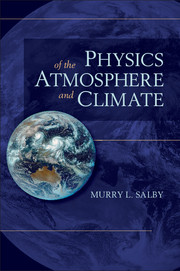Book contents
- Frontmatter
- Contents
- Preface
- Prelude
- 1 The Earth-atmosphere system
- 2 Thermodynamics of gases
- 3 The Second Law and its implications
- 4 Heterogeneous systems
- 5 Transformations of moist air
- 6 Hydrostatic equilibrium
- 7 Static stability
- 8 Radiative transfer
- 9 Aerosol and cloud
- 10 Atmospheric motion
- 11 Atmospheric equations of motion
- 12 Large-scale motion
- 13 The planetary boundary layer
- 14 Wave propagation
- 15 The general circulation
- 16 Dynamic stability
- 17 Influence of the ocean
- 18 Interaction with the stratosphere
- Appendix A Conversion to SI units
- Appendix B Thermodynamic properties of air and water
- Appendix C Physical constants
- Appendix D Vector identities
- Appendix E Curvilinear coordinates
- Appendix F Pseudo-adiabatic chart
- Appendix G Acronyms
- Answers to selected problems
- References
- Index
- Plate section
10 - Atmospheric motion
Published online by Cambridge University Press: 05 June 2012
- Frontmatter
- Contents
- Preface
- Prelude
- 1 The Earth-atmosphere system
- 2 Thermodynamics of gases
- 3 The Second Law and its implications
- 4 Heterogeneous systems
- 5 Transformations of moist air
- 6 Hydrostatic equilibrium
- 7 Static stability
- 8 Radiative transfer
- 9 Aerosol and cloud
- 10 Atmospheric motion
- 11 Atmospheric equations of motion
- 12 Large-scale motion
- 13 The planetary boundary layer
- 14 Wave propagation
- 15 The general circulation
- 16 Dynamic stability
- 17 Influence of the ocean
- 18 Interaction with the stratosphere
- Appendix A Conversion to SI units
- Appendix B Thermodynamic properties of air and water
- Appendix C Physical constants
- Appendix D Vector identities
- Appendix E Curvilinear coordinates
- Appendix F Pseudo-adiabatic chart
- Appendix G Acronyms
- Answers to selected problems
- References
- Index
- Plate section
Summary
Under radiative equilibrium, the First Law reduces to a balance between radiative transfers of energy. This simple energy balance determines the radiative-equilibrium thermal structure. It is valid for a resting atmosphere. However, radiative equilibrium breaks down for an atmosphere in motion. Heat is then also transferred mechanically, by air motion. The radiative-equilibrium thermal structure (Fig. 8.21) differs conspicuously from the observed global-mean temperature (Fig. 1.2). Under radiative equilibrium, temperature is much too warm at the surface. It decreases upward too steeply. The discrepancy from observed temperature points to the importance of mechanical heat transfer. Under radiative-convective equilibrium, mechanical heat transfer is accounted for – by convection. It reconciles the equilibrium thermal structure with that observed, but only vertical structure that is characteristic of the global-mean.
Horizontal thermal structure differs significantly from that observed (Fig. 10.1). Under radiative-convective equilibrium (Fig. 10.1a), temperature decreases poleweard at all latitudes, from ∼315 K over the equator to colder than 180 K over the winter pole. Observed zonal-mean temperature (Fig. 10.1b) decreases poleward more gradually. It is some 20 K cooler over the equator and 40 K warmer over the winter pole. By comparison, radiative-convective equilibrium produces a meridional temperature gradient that is too steep. It accounts for mechanical transfer of heat, but only in the vertical.
At observed temperatures, individual latitudes are not in radiative equilibrium, not even in radiative-convective equilibrium. According to the distribution of net radiation (Fig. 1.34c), low latitudes experience radiative heating.
- Type
- Chapter
- Information
- Physics of the Atmosphere and Climate , pp. 328 - 344Publisher: Cambridge University PressPrint publication year: 2012



